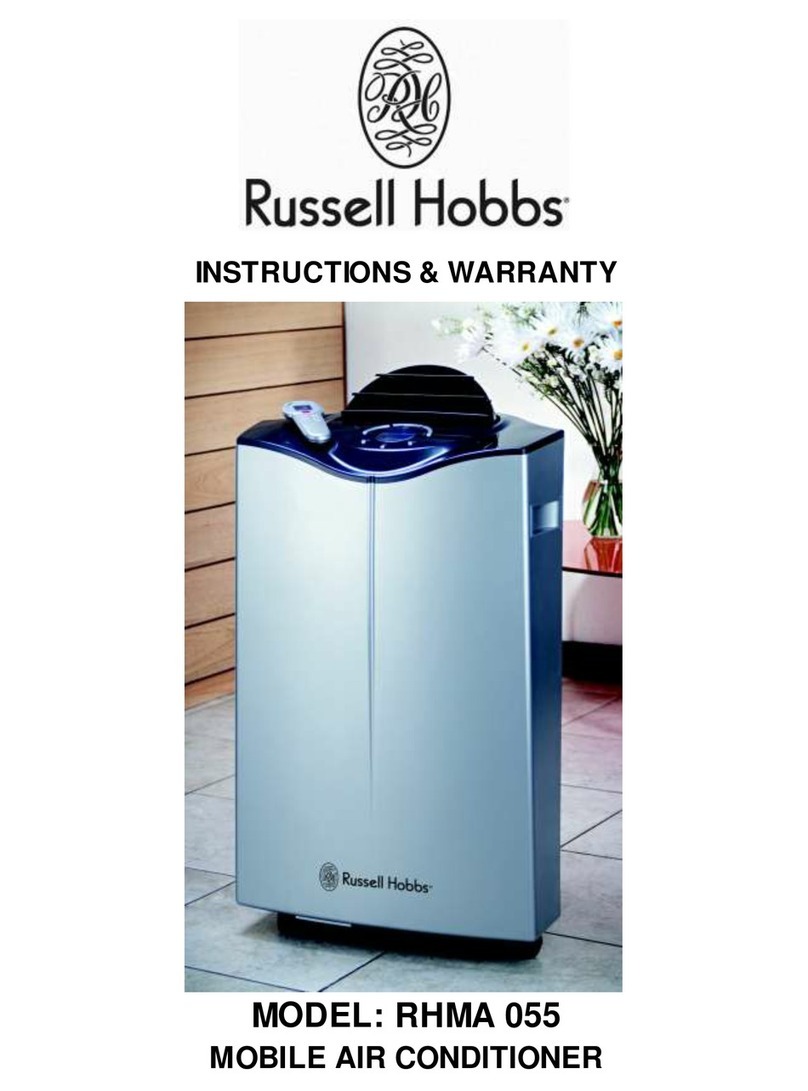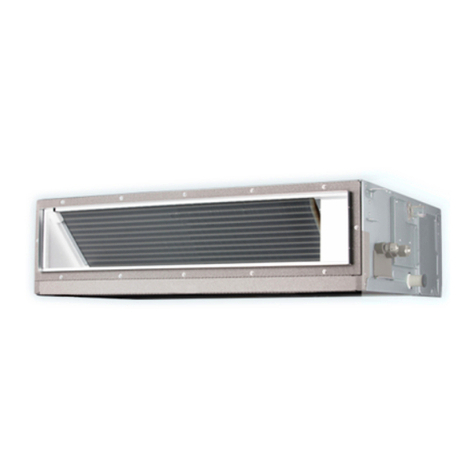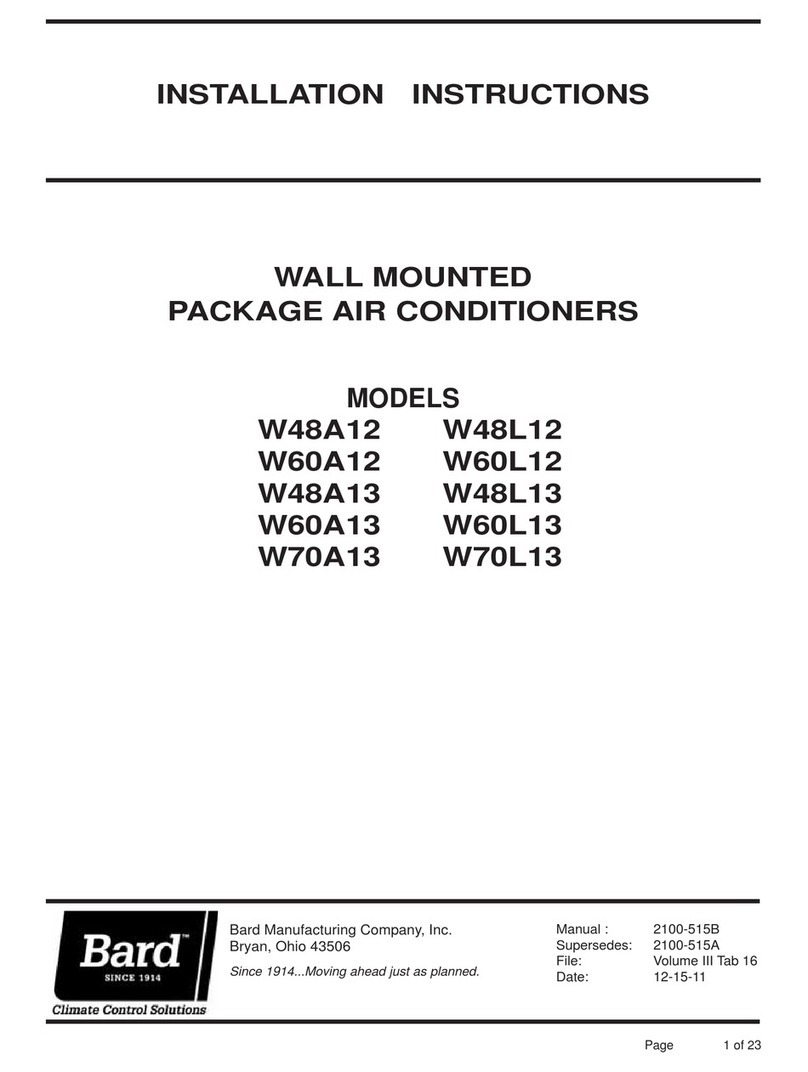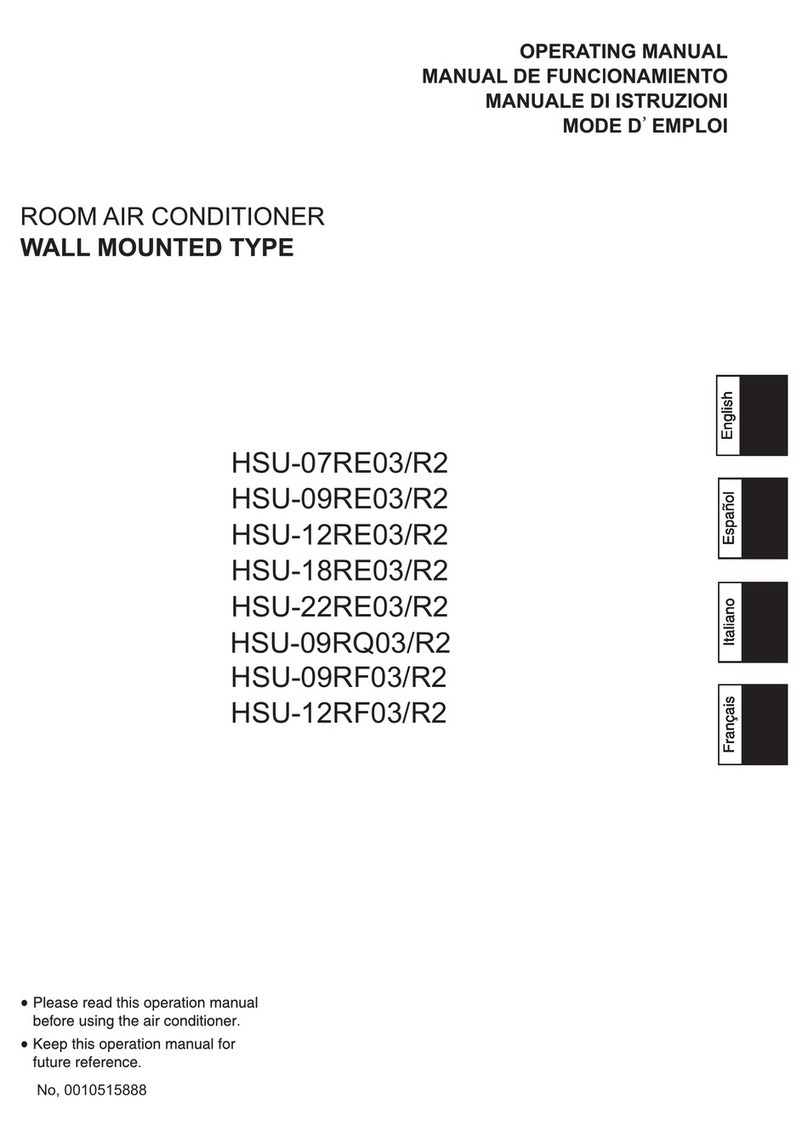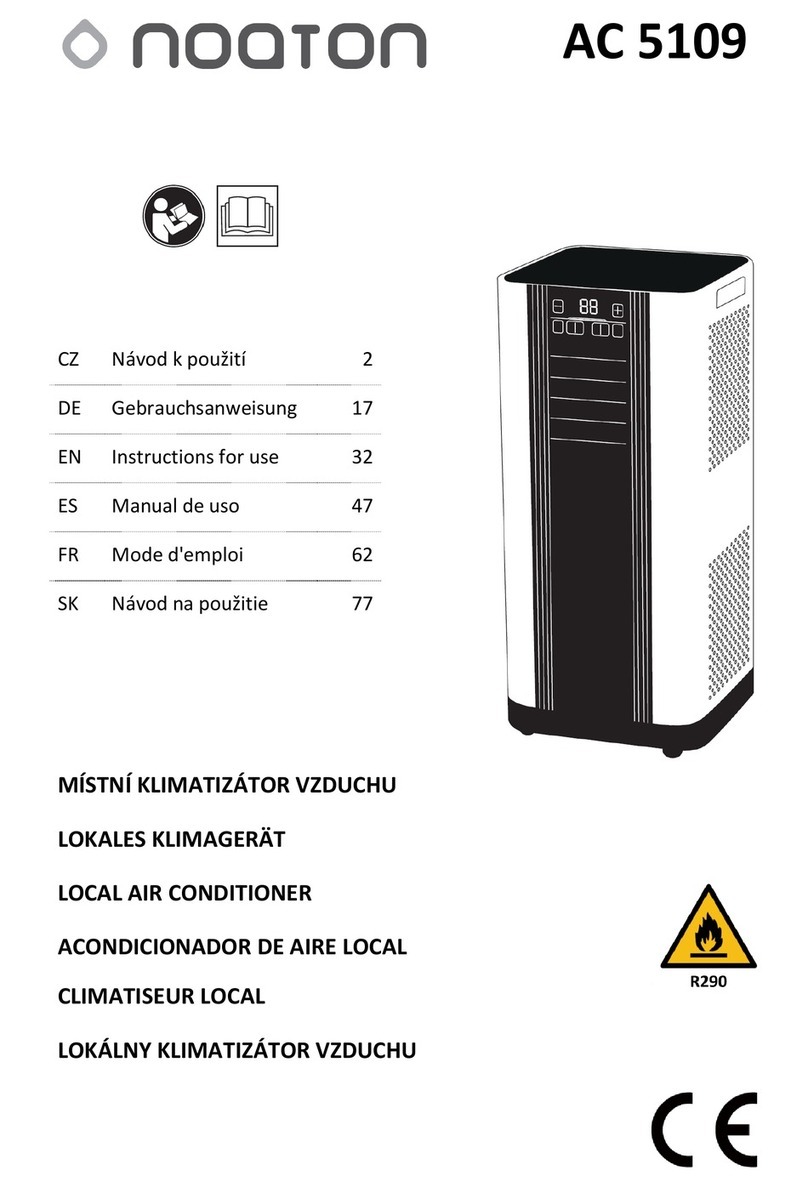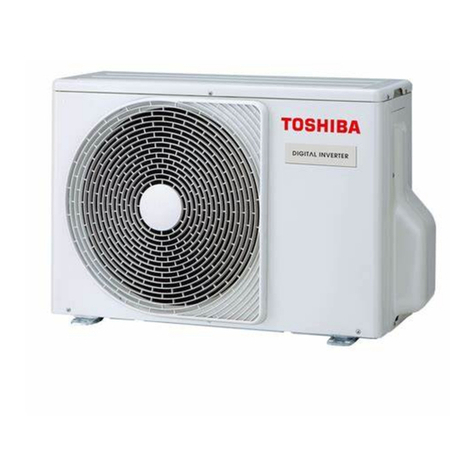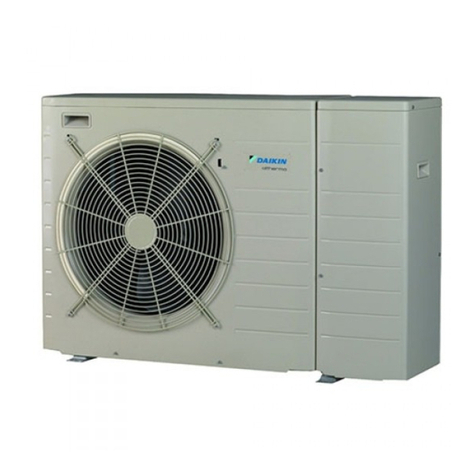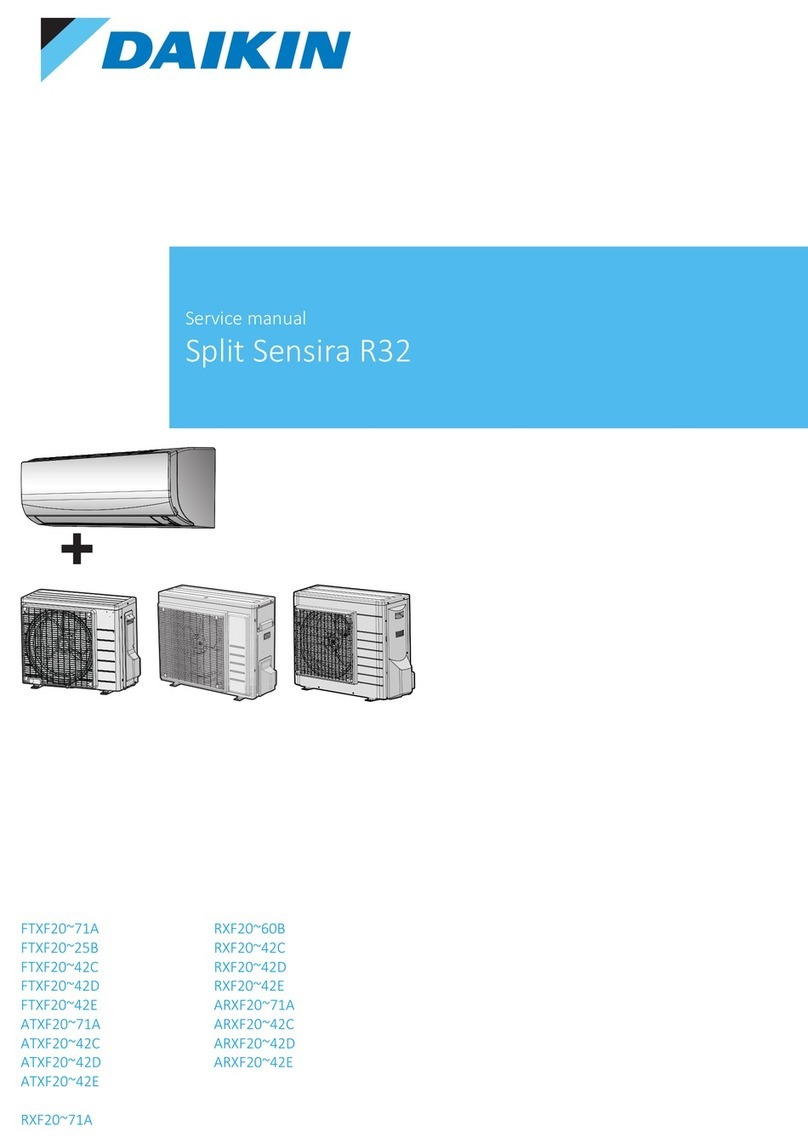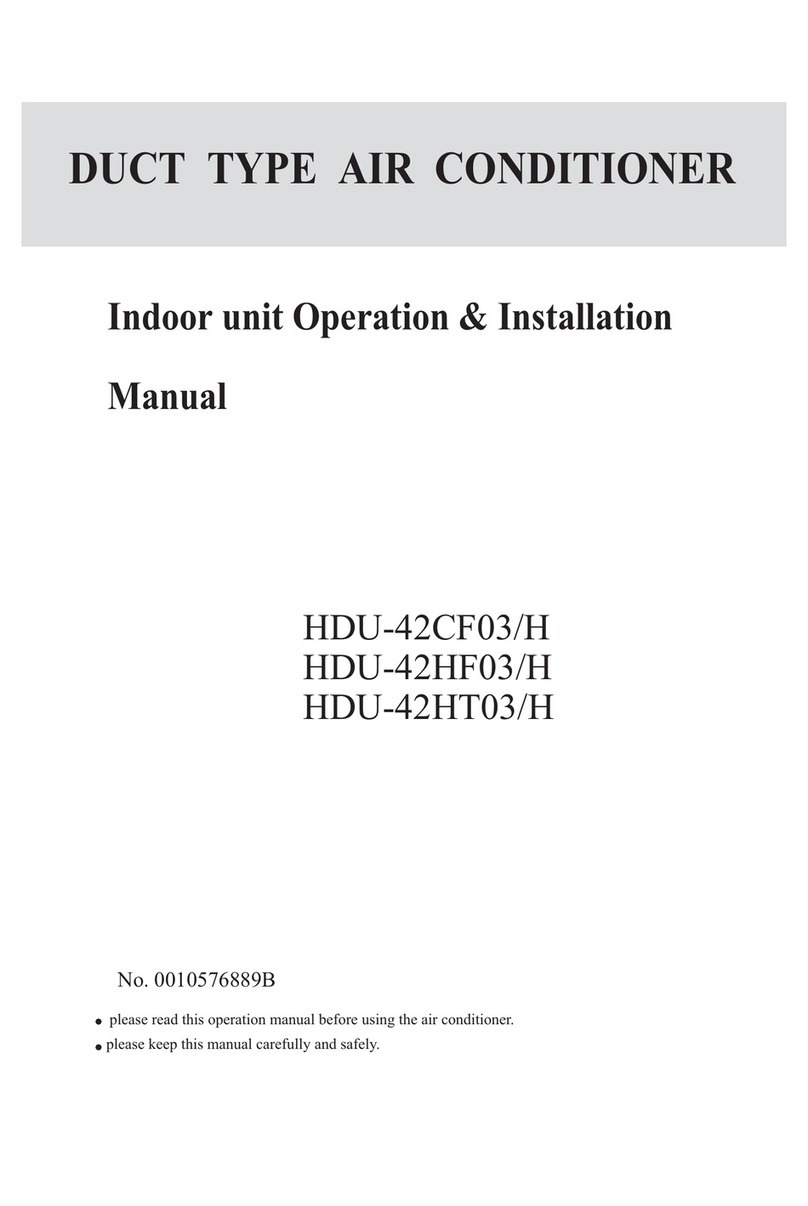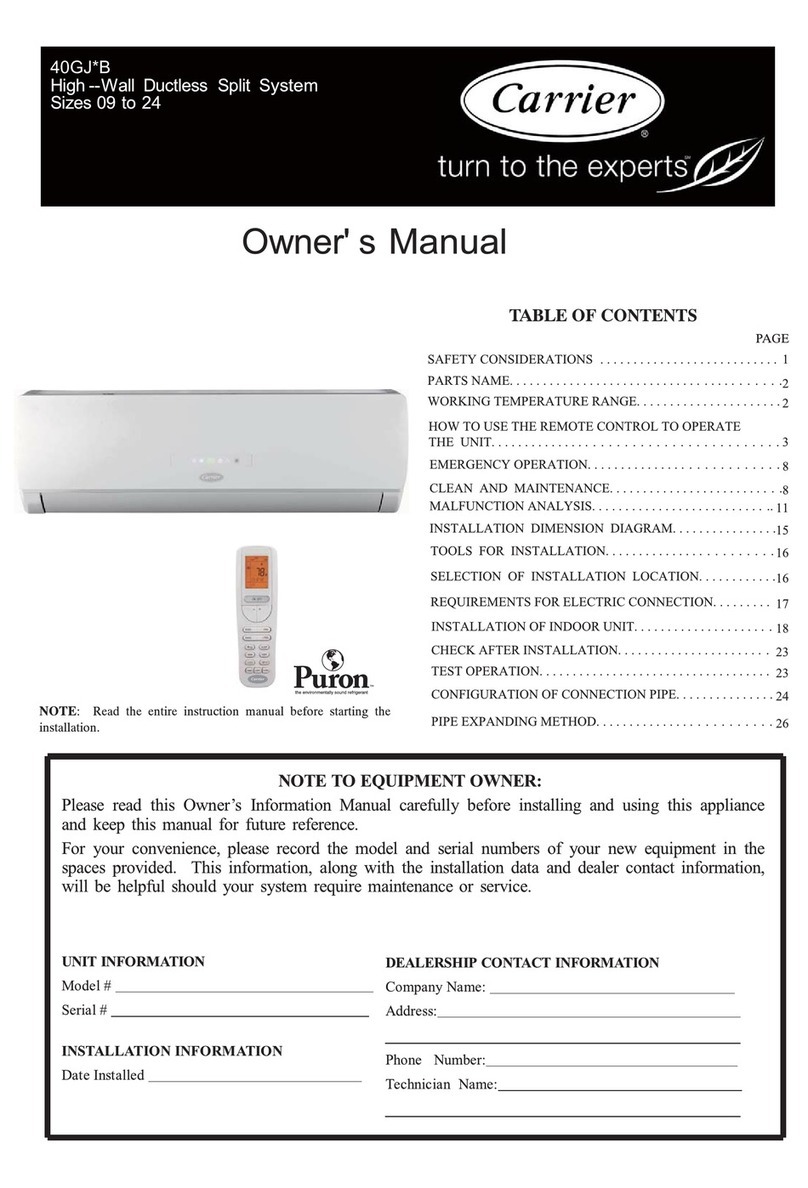GE Consumer & Industrial GE AIR 107 Operating instructions

Wall Mounted
Split Air-Conditioner
Owner’s Manual and Installation Instructions
GE Consumer & Industrial
Appliances
GE imagination at work
English

3
English
Contents
o get the full benefit from your new air-conditioner, please read this
Owner’s Manual carefully before operating the unit.
hank you for choosing a GE air-conditioner.
Please keep this document for future consultation.
Owner’ s Manual 4
Import safety information 4
Name and function of parts 5
Remote control 6
How to operate your air-conditioner 8
How to insert batteries 10
User notices 10
Care and maintenance 11
roubleshooting 13
Installation instructions 15
Accessories and installation diagram 15
General installation instructions 16
Installing the indoor unit(s) 18
Installing the outdoor unit 23
est operation and after installation check 25
echnical specifications 27
Models covered in this document:
GE
GE AIR 107 - GE AIR 109 - GE AIR 112 - GE AIR 116 - GE AIR 121
GE AIR 218 - GE AIR 224
GE AIR 326
GE AIR 428
GE Profile
PRO AIR 107 - PRO AIR 109 - PRO AIR 112
PRO AIR 218
GE Profile Inverter
PRO AIR I109 - PRO AIR I112

5
English
4
• Make sure you push the power plug all
the way into the socket. Failure to do so
can cause an electric shock, overheating
or even a fire.
• Do not remove the power plug while the
machine is operating except in an
emergency.
• Never use an extension cord or splice the
power cord.
• Never share the same power outlet with
another electric appliance.
• Do not insert the power plug into the
outlet with wet hands.
• Never insert fingers or objects into the air
intake or outlet vents.
• Do not aim chilled or heated air directly
onto the body for long periods.
• Disconnect the power supply
immediately if you smell burning or
smoke and contact your service center.
• Do not attempt to repair the air-
conditioner yourself.
• Consult with a professional electrician to
ensure that adequate circuit breakers,
fuses and other safety devices are in
place.
• Disconnect the unit whenever it will be
out of service for extended periods.
• Always disconnect the power supply
before cleaning the machine.
• Never pull on the cord to remove the
power plug.
• Do not place a space heater near the
air conditioner. Airflow from the air
Important safety information
Read all instructions efore use
conditioner can cause incomplete
combustion in a space heater, resulting
in dangerous fumes.
• Keep combustible sprays away from the
unit.
• Ensure that the unit is mounted securely.
• Do not place objects on the unit.
• Never block the air intake or outlet vents.
• he indoor unit must be installed at least
2,0 m from the ground.
• Extreme temperature differentials can be
harmful to health.
• Do not use the air-conditioner for drying
clothes, preserving foods or other
functions for which it was not designed.
• Splashing water on the unit may cause
an electric shock and malfunction.
• he ground (earthing wire) must be
properly connected. Do not connect the
earth wire to a gas or water pipe,
lightning rod or telephone earth lines.
• he unit must be operated with a stable
voltage in the range of 198-253 Volts.
Name and function of parts
1. Surface panel
2. Air filters and cleaners
3. Shell
4. Key switch1
5. Louver
6. Power plug2
7. Drain hose
8. Wireless remote controller
9. Connection pipe3
10.Air outlet cover
➁
➂
➃
➄
➅
➆
➇
➈
➉
➀
Air in
Air in
Air out
Air out
(1) Not on models GE AIR 116, GE AIR 121, PRO AIR I109 and PRO AIR I112.
(2) These models do not have a po er plug on the indoor unit as they are po ered through the outdoor unit:
GE AIR 218, GE AIR 224, GE AIR 326, GE AIR 428, PRO AIR 218. GE AIR 116 and GE AIR 121 are po ered
through the indoor unit and do not have a po er plug.
(3) The follo ing models have more than one indoor unit and t o connection pipes. Models not mentioned
belo have one indoor unit and t o connection pipes.
- T o indoor units and four connection pipes for models GE AIR 218, GE AIR 224 and PRO AIR 218
- Three indoor units and six connection pipes for model GE AIR 326
- Four indoor units and eight connection pipes for model GE AIR 428
Owner’s Manual
WARNING!
Use this appliance only for its intended purpose as descri ed in this Owner’s Manual
When using electrical appliances, asic safety precautions should e taken, including the
following:

7
English
6
Remote control
Remote controller ith cover closed
General remarks
• Be sure there are no obstructions
between the receiver and the remote
control unit. he unit has a range of
approximately 8 meters.
• Do not expose the remote control unit to
moisture, excessive direct sunlight or heat.
• Do not drop or throw the remote
control unit.
• When restarting, the unit resumes
operating on the last mode set before
shut down. he outdoor unit will restart in
approximately 30 seconds.
1. ON/OFF button
Press this button to turn the unit on or off.
Additional control buttons are available under the s ing
out door.
2. EMP button
Set temperature up or do n by 1°C by pressing the
PLUS (+) or MINUS (-) button once. Temperature can be
set on COOL, DRY and HEAT modes bet een 16°C and
30°C. HEAT mode not available on models
GE AIR 326 and GE AIR 428.
3. MODE button
Select the desired mode of operation by pushing this
button. The unit can operate on: AUTO, COOL, DRY, FAN
or HEAT modes. Heat mode not available on models
GE AIR 326 and GE AIR 428.
4. FAN button
Press this button to change fan speed.
There are three speeds to choose from, or set the
FAN to AUTO to let the unit control the air flo .
5. SWING button
Press to start louver moving automatically.
Press again to stop louver moving.
AUTO mode
COOL mode
DRY mode
FAN mode
HEAT mode
➁
➃
➀➂
➄
Remote controller ith cover open
➂
➀
➁
1. SLEEP button
Press to set the sleep function.
2. IMER ON button
When the unit is off, press TIMER ON button to turn it on
automatically at a specified time up to 24 hours ahead.
3. IMER OFF button
Press TIMER OFF button to set the time the unit
automatically turns itself off up to 24 hours ahead.
Note: the AIR, HUMID, ANION and SAVE features are not
available on models covered by this manual.

9
English
8
How to operate your
air-conditioner
• AUTO mode operation
In AU O mode, the microcomputer
automatically controls the rate of cooling
and heating of the room (only cooling for
models GE AIR 326 and GE AIR 428). If the
room temperature is higher than 25ºC,
the unit will automatically switch to COOL
mode. On models PRO AIR I109 and PRO
AIR I112, if the room temperature is lower
than 20ºC, the unit will automatically
switch to HEA mode. On all other
models, the unit switches to HEA mode
below 18ºC. If the fan speed is set at
AU O mode, the microcomputer will
control the speed of the indoor fan
according to the target temperature.
• FAN mode operation
Use the FAN mode to ventilate air in the
room without cooling, heating or drying
the air. Use the FAN button of the remote
controller to set the fan speed.
• TIMER ON operation
he IMER ON mode can only be set while
the unit is not in operation. When the unit
is stopped, press IMER ON button to turn
it on automatically at a specified time up
to 24 hours ahead. o cancel the IMER
ON setting, press again IMER ON button.
• TIMER OFF operation
he IMER OFF mode can only be set
while the unit is in operation. When the
unit is in operation, press IMER OFF
button to turn it off automatically at a
specified time up to 24 hours ahead. o
cancel the IMER OFF function, press
again IMER OFF button.
• COOL mode operation
he microcomputer automatically
controls the rate of cooling. It adjusts the
operation of the unit according to the
actual room temperature and the desired
temperature. If the room temperature is
higher than the desired temperature, the
unit will cool the air of the room. If the fan
speed is set at AU O mode, the
microcomputer will control the speed of
the indoor fan according to the target
temperature.
• HEAT mode operation (not available on
models GE AIR 326 and GE AIR 428)
he microcomputer automatically
controls the rate of heating. It adjusts the
operation of the unit according to the
actual room temperature and the desired
temperature. If the room temperature is
lower than the desired temperature, the
unit will heat the air of the room. If the fan
speed is set at AU O mode, the
microcomputer will control the speed of
the indoor fan according to the target
temperature.
• DRY mode operation
Use the DRY mode to both cool the air
and reduce the moisture contained in the
air. he microcomputer automatically
adjusts the operation of the unit
according to the actual dryness and
temperature of the room, and according
to the desired temperature. If the room
temperature is higher than the target
temperature, the unit will both cool and
dry the air of the room. If the fan speed is
set at AU O mode, the microcomputer
will control the speed of the indoor fan
according to the target temperature.
• SLEEP mode operation
When the unit is cooling or drying and
operating in SLEEP mode, the target
temperature will gradually increase by
1°C per hour for two hours.
When the unit is heating and operating in
SLEEP mode, the target temperature will
gradually decrease by 1°C per hour for
two hours.
• Auto-restart function
If the network loses power, and if the unit
was in operation when the power cut
occurred, it will automatically restart
when the network regains power.
On all models except GE AIR 116 and GE
AIR 121: if your air-conditioner was not in
operation before a power cut and
automatically switches on when the
network regains power, check the
following.
- Remove surface panel of indoor unit.
- Check the switch located on the right
of the unit is set on RUN.
- If it not set on RUN, use a screw driver
to set it to RUN.
AUTO
TEST
RUN
STOP

11
English
10
How to insert atteries into the
remote control unit
• Slide the battery cover off from the back
of the remote control unit.
• Insert two AAA batteries and press the
‘ACL’ button.
• Slide the cover back in place.
NOTE:
• Do not mix new and used batteries or
rechargeable and non-rechargeable
batteries.
• Remove batteries from the remote
control unit when it is out of service for
long periods.
• Fresh batteries can normally be expected
to last up to one year.
• Operate the remote control unit at least
1 meter or more away from a television
or audio device.
• Do not aim the air current directly at
animals or plants.
• Disconnect the power if the unit is out of
service for extended periods.
• Clean the air filter and maintain the air
cleaner on a regular basis.
• Remove batteries if the remote controller
is out of service for long periods.
• Avoid strong sunlight and draw curtains
or shades when cooling.
• Keep windows and doors shut to avoid
the loss of conditioned air.
• Select the most appropriate temperature
to save energy. Keep the room
approximately 5°C cooler than the
outside temperature when operating in
COOL mode.
• Adjust the direction of the airflow
appropriately. Remember that warm air
rises and cool air sinks, so adjust the
louver downward for heating and upward
for cooling to take advantage of natural
convection currents.
User notices
CAUTION
• Always turn power off and remove the
power plug efore cleaning the unit.
• NEVER sprinkle water on either the
indoor or the outdoor unit to clean it.
• Wipe the indoor and outdoor units with
a clean, soft dry cloth or a cloth slightly
moistened with water or cleaner.
• Before starting the unit, e sure that
nothing o structs the air outlet and the
intake vents.
Care and maintenanceHow to insert atteries
Cleaning the outdoor unit
1. Regularly clean dust from outdoor unit.
2. Repaint any rust colored areas on the
outdoor unit.
Cleaning the indoor surface panel
1. Pull in the direction indicated by the
arrows to remove surface panel.
2. Wipe with a cloth slightly moistened with
water or cleaner and then dry in the
shade. Do not use water above 45°C to
wash the panel. It could cause
deformation or discoloration.
3. Reinstall the surface panel.

13
English
12
Trou leshooting
If a malfunction occurs, check the following
before contacting your service center.
Pro lem
Indoor unit does not start immediately
when the air-conditioner is switched on
An unusual smell coming from the outlet
after the unit begins operating
A sound like water flowing can be heard
during operation
Mist is emitted during cooling mode
Creaking noise can be heard when the unit
starts or stops
he air conditioner does not operate at all
Cooling or heating efficiency is not good
he wireless remote controller does not
function
Trou leshooting
Once the air-conditioner is stopped, it will
not operate for approximately three
minutes while the refrigerant settles down.
his is usually temporary and caused by
odors concentrated in the air intake going
into the air conditioner. If it continues, turn
power off and contact your service center.
his is a normal sound caused by the
refrigerant flowing inside the unit.
his is normal. he conditioned air cools
down the room air rapidly and it sometimes
looks like fog.
his is a temporary phenomenon caused by
the deformation of plastic due to the
change in temperature. If it continues,
contact your service center.
Please check for the following:
1. Is a power connection loose?
2. Is the circuit breaker activated?
3. Is the voltage higher than 253 volts or
lower than 198 volts?
4. Is IMER ON in operation?
1. Is the set temperature suitable?
2. Is the air inlet or outlet obstructed?
3. Are the air filters dirty or clogged?
4. Is the indoor fan speed set too low?
5. Is there another heat source in the room?
1. Is the remote controller unit out of range
(more than 8 meters from unit)?
2. Replace worn out batteries.
3. Are there any obstructions between the
wireless remote controller and the signal
receiver?
Replacing the indoor air cleaners
(Recommended once every six months.
Air cleaners are available from your
GE distributor.)
1. Remove the surface panel and the air
filters.
2. Remove old air cleaners and place new
cleaners into the filter frame. Be careful
not to injure yourself on the fins.
3. Reinsert the filters and reinstall the
surface panel.
Cleaning the indoor air filters
(It is recommended that the air filters be
cleaned once every three weeks.)
1. Open the surface panel, take hold of
the air filter tab, raise it slightly, and then
remove it.
2. Vacuum dust from the filters or wash
them with water and dry them in the
shade.
Note: Do not use water above 45°C to
wash the filters. It may cause
deformation or discoloration.
3. Reinstall the filters with the side marked
‘front’ facing forward. Reinstall the
surface panel.

15
English
14
Installation instructions
Accessories and
installation diagrams
Use only the accessories listed below for the
installation. Failure to do so may lead to gas
leakage, electric shock, a fire hazard or other
possible safety hazards.
Check all parts listed below are present
before proceeding with the installation.
Part PRO AIR PRO AIR PRO AIR GE AIR GE AIR
I100 series 100 & GE 200 & GE 326 428
AIR 100 AIR 200
series series
Rear panel 1 1 2 3 4
Remote controller 1 1 2 3 4
Battery 2 2 4 6 8
Cords 1 2*545
apping screw 10 10 20 30 40
Plastic drain hose 1 1 2 3 4
Piping hole sleeve 2 2 4 6 8
Wrapping tape 1 1 2 3 4
Connection piping 1 1 2 3 4
hermal insulation hose 1 1 2 3 4
Outdoor drain elbow 1 1 2
Outdoor drain stem 2 2 4
Air cleaner 2 2 4 6 8
Square ring 1** 222
Immediately stop all operations, disconnect
the power and contact your nearest service
center in the event any of the following
happens:
• Unusual noise while the unit is operating
• Power fuse or breaker switch repeatedly
activates
• Water or fluid splashes into the unit
• Electrical wirings and power plug become
very hot
• An unpleasant smell is emitted during
operation
(*) 3 for GE AIR 116 and GE AIR 121
(**) only on GE AIR 116 and GE AIR 121

17
English
16
The above diagram represents models ith one indoor unit and t o
connection pipes. Some models have more than one indoor unit and
t o connection pipes. These models are listed belo .
- t o indoor units and four connection pipes for models GE AIR 218,
GE AIR 224 and PRO AIR 218
- three indoor units and six connection pipes for model GE AIR 326
- four indoor units and eight connection pipes for model GE AIR 428
General installation
instructions
IMPORTANT NOTES
• The installation must e carried out y
trained and qualified service personnel
according to the instructions contained
in this manual.
• Contact your service center efore
eginning installation to avoid possi le
malfunctions.
• When picking up and moving the unit,
e guided y trained and qualified
personnel.
• The ground connection of the air-
conditioner must e made correctly and
securely to the recommended earth
ground points. Contact the service
center if you have any question.
• Installation in the following places may
cause malfunction:
- Any place where machine oil is used.
- Any site with a lot of salinity.
- Any site with sulfured gas such as
hot springs.
- Any site su ject to high-frequency
waves such as places close to radio
equipment, welders and medical
equipment.
- Any place under strong
electromagnetic fields or in a
chemical environment.
• If the air-conditioner has to e installed
on such a site, contact your service
center for advice.
> 15 cm
> 15 cm
> 15 cm
> 200 cm
> 50 cm
> 30 cm
> 50 cm
> 200 cm
> 30 cm

19
English
18
4. Connect the wires strictly based on the
correspondence between the wire colors
and the terminal block codes as
described in table 2.
5. If the indoor unit has a plastic connector
(wiring interface), connect the
corresponding cable and clamp the
connected cord onto the chassis.
6. For models GE AIR 116 and GE AIR 121,
put the terminal block back in its position
and screw it to the body of the unit.
7. Re-assemble the wiring cover plate.
8. Re-assemble the surface panel.
Installing the indoor unit(s)
hese instructions must be repeated for
each indoor unit. he number of indoor units
per model is as follows.
• One indoor unit: GE AIR 107, GE AIR 109,
GE AIR 112, GE AIR 116, GE AIR 121, PRO
AIR 107, PRO AIR 109, PRO AIR 112, PRO
AIR I109, PRO AIR I112
• wo indoor units: GE AIR 218, GE AIR 224
and PRO AIR 218
• hree indoor units: GE AIR 326
• Four indoor units: GE AIR 428
Choose installation location
1. he height of installation should be 2
to 3 meters from the floor.
2. he air inlet and outlet of the indoor unit
should not be covered or blocked in any
way so that the conditioned air can reach
all parts of the room.
3. Select a location which enables easy
connection with the outdoor unit. ake
into consideration the maximum allowed
length and height of piping. his data is
provided in the specification table at the
end of this manual.
4. Select a location where accumulated
condensation can be drained
conveniently.
5. Avoid locations near a heat source, high
humidity or an inflammable gas.
6. Select a location strong enough to
withstand the full weight and vibration of
the unit.
7. he location should conform to the
installation dimension diagram.
8. Be sure to leave enough space to allow
access for routine maintenance.
9. Install at least 1 meter away from other
electric appliances such as television,
audio device, etc.
10.Choose a location where it is easy to
remove and clean the filter.
11.Do not install the unit in the immediate
vicinity of a laundry, bath, shower or
swimming pool.
12. he power plug must be accessible after
the appliance is correctly positioned.
Install the rear panel
1. Always mount the rear panel horizontally.
2. Fix the rear panel on the selected location
with the screws supplied with the unit.
3. Be sure the rear panel is firmly fixed.
he mounting must be able to withstand
a weight of at least 60 kilograms.
he weight should be evenly shared by
each screw.
Electrical wiring
WARNING! Both the indoor and the
outdoor units must e properly earthed.
Refer to table1 and table 2 below to identify
the required electrical wiring for your air-
conditioner. he indoor units of models GE
AIR 116 and GE AIR 121 are pre-wired. o
connect the other models, or to change the
pre-wired cables on models GE AIR 116
and GE AIR 121, follow these instructions.
1. Open the indoor unit surface panel.
2. Remove the wiring cover located on the
right of the unit.
3. If you need to connect a cable to the
terminal block (see table 1), route the cord
from the back of the indoor unit and pull
it towards the front through the wiring
hole for connection. On models GE AIR
116 and GE AIR 121, unscrew the terminal
block and pull it slightly out to be able to
access all terminal connections with a
screw driver.
Model
GE AIR 107
GE AIR 109
GE AIR 112
GE AIR 116
GE AIR 121
GE AIR 218
GE AIR 224
GE AIR 326
GE AIR 428
PRO AIR 107
PRO AIR 109
PRO AIR 112
PRO AIR 218
PRO AIR I109
PRO AIR I112
Ca les etween indoor and
outdoor units
1 for power (terminal block)
+ 1 for signal (terminal block)
1 for power (terminal block)
+ 1 for signal (connector) on
each indoor unit
1 for both power and signal
(terminal block) for each
indoor unit
1 for power (terminal block)
+ 1 for signal (terminal block)
1 for power (terminal block) +
1 for signal (connector) on
each indoor unit
1 for both power and signal
(terminal block)
Main power ca le
on indoor unit
with plug
on indoor unit
without plug
on outdoor unit
without plug
on indoor unit
with plug
on outdoor unit
without plug
on indoor unit
with plug
Table 1

21
English
20
NOTES:
1. All electrical work must e performed
y qualified personnel according to
local regulations and this manual.
2. The exclusive power line with rated
voltage must e used.
3. Circuit reaker must e installed
etween the air-conditioner and the
power line.
4. Make sure the specified circuit reaker
is used.
5. If the power supply cord of the unit is
damaged, it must e replaced with a
special cord availa le from the
manufacturer or its service agent.
6. The diameter of the power connecting
ca le must e equal to or exceed the
specified value to operate the air-
conditioner safely.
7. Wiring work must conform to national
standards.
Model
GE AIR 107 / GE AIR 109
GE AIR 112 / PRO AIR 107
PRO AIR 109 / PRO AIR 112
GE AIR 116 / GE AIR 121
GE AIR 218 / GE AIR 224
PRO AIR 218
GE AIR 326 / GE AIR 428
PRO AIR I109 / PRO AIR I112
Indoor terminal
lock
N
2
4
5
ground
N
2
3
4
5
N
2
3
ground
-
-
-
N(1)
2
3
ground
-
-
-
N(1)
2
3
ground
Ca le wire
Blue
black
violet
orange
yellow / green
blue
black
brown
violet
orange
blue
black
brown
yellow / green
brown
blue
yellow / green
blue
brown
black
yellow / green
brown
blue
yellow / green
blue
black
brown
yellow / green
Outdoor terminal
lock
N
2
4
5
ground (on chassis)
N
2
3
4
5
N(1)
2
3
ground (on chassis)
L
N
ground
N
L1
L2
ground (on chassis)
L
N
ground
N(1)
2
3
ground (on chassis)
Table 2

23
English
22
Choose installation location
1. Select a location where noise and outflow
air will not inconvenience neighbors.
2. Select a location with sufficient ventilation.
3. he inlet and outlet should never be
blocked or covered.
4. he location should be able to withstand
the full weight and vibration of the unit.
5. Avoid installation in any area where a
danger of flammable gas or of corrosive
gas leaks exists.
6. Ensure that the installation location
conforms to the requirements of the
installation dimension diagram.
Install the connection pipe
1. On model GE AIR 326, make sure to
connect the large capacity indoor unit
(GE AIR 326 IN2) to the outdoor unit valves
identified with the letter A. he valves
identified with letters B and C correspond
to the small capacity unit (GE AIR 326 IN1).
2. Align the center of the piping flare with
the relevant valve.
3. Fasten the nut to the flare by hand and
then tighten the nut with torque wrench
to specifications listed in table below.
Refer to Fig. 3.
4. Cover piping joints with pipe cover.
5. Insulate piping with thermal insulation
hose provided with the unit.
Note: excessive tightening torque will
damage the flare surface. Use table 3 to
identify the appropriate torque.
Electrical wiring connection
Refer to table 1 and table 2 to identify
the required electrical wiring for your
air-conditioner.
1. Remove the wiring cover.
2. Remove wire clamp(s).
3. Connect the wires to the terminal block
strictly based on the correspondence
between the wire colors and the terminal
block codes provided in table 2. Clamp
the connected cord onto the chassis.
4. Make sure each wire is connected to the
right terminal pin of the outdoor terminal
block and corresponds to the right
terminal pin of the indoor unit.
5. If the outdoor unit has a plastic connector
(wiring interface), connect the
corresponding cable and clamp the
connected cord onto the chassis.
6. Make sure that the wiring has been
connected firmly.
7. Re-assemble cover.
NOTE:
• Wrong wire connections will cause
electrical malfunction.
• Do not pull down the connecting ca le
when fixing it with the wire clamp.
• Make sure the wires are securely
connected to the terminal lock and the
connecting ca le is firmly held y the
wire clamp.
Installing the outdoor unit
Fig. 3
Pipe diameter orque
(mm) (Nm)
6,35 15-20
9,52 31-35
12,7 50-55
15,8 60-65
Table 3Install the piping hole
1. Make the piping hole (Ø100 mm for
models GE AIR 116 and GE AIR 121, and
Ø80 mm for all other models) in the wall
at a slight downwards slant.
2. Insert the piping hole sleeve into the hole
to prevent the connection piping and
wiring from being damaged while passing
through the hole.
Install the connection pipes
1. When routing the piping and wiring from
the left or right side of the indoor unit,
cut out the tailings from the chassis if
necessary (shown in Fig. 1). Cut out
tailing 1 when routing wiring only.
Cut out tailing 2 when routing both
the wiring and piping.
2. Connect the pipes with the appropriate
union pipes on the indoor unit.
3. Cover piping joints with pipe cover.
4. Insulate piping with thermal insulation
hose provided with the unit.
NOTE:
1. The connection pipes should e
connected to the indoor unit first and
the outdoor unit second.
2. Be careful when ending the connection
pipes so as not to damage them.
3. Do not end a connection pipe more
than three times in the same location.
4. Make sure the maximum length and
height falls within the limits provided in
the specification ta le at the end of this
manual.
5. Leakage will occur if the torque is too
great when tightening the flare nuts.
Refer to ta le 3 on page 23 to identify
the appropriate torque.
Install the drain hose
1. Place the drain hose at a downward slant
for optimal drainage.
2. Do not wrench or bend the drain hose or
flood the end with water.
Last steps for installing the indoor unit
1. Wrap the piping and wiring and pull them
through the cut out tailing hole as shown
in Fig. 2.
2. Lift the surface panel of the indoor unit
and install the air cleaners.
3. Pull the piping through the connection
pipe hole and hang the two mounting
slots of the indoor unit on the proper tabs
of the rear panel and check that it is
mounted strong enough.
Fig. 2
Connection
cord
Connection
pipes
Wrapping
tape
Drain
hose
Fig. 1
Tailing 3 Tailing 2
Tailing 1

25
English
24
Test operation and after
installation check
Before testing:
1. Do not turn power on until installation is
completely finished.
2. Electric wiring must be connected
correctly and securely.
3. Open all cut-off valves on the connection
pipes.
4. All impurities and debris such as scraps
and filings must be cleared from the unit.
Test operation method:
1. On models other than GE AIR 116, GE
AIR 121, PRO AIR I109 and PRO AIR I112
a. Remove the surface panel of indoor
unit,
b. Use a screw driver to set the switch on
the right of the unit to RUN.
2. Switch power on and press ON/OFF
button on the remote controller.
3. Press MODE button and check the
operating condition of each of the COOL,
HEA and FAN modes. he HEA mode is
not available on models GE AIR 326 and
GE AIR 428.
4. If the remote control cannot be used,
employ the following forced operation:
a. For models GE AIR 116, GE AIR 121,
PRO AIR I109 and PRO AIR I112
- With the unit stopped, remove the
surface panel and switch the unit to
AU O mode by pressing the button
located on the right.
- he unit will automatically run in
the mode selected by the
microcomputer according to the
surrounding temperature.
- With the unit running, press the
button to turn the unit off.
b. For all other models:
- With the unit stopped, remove the
surface panel and set switch on the
right of the unit to AU O mode.
- he unit will automatically run in
the mode selected by the
microcomputer according to the
surrounding temperature.
- With the unit running, set the
switch to S OP to turn the unit off.
- Once the tests are completed, set
switch to RUN for normal
operations. If the switch is not set
to RUN, the unit will start
automatically every time it is
connected to the power grid or
after a power cut.
AUTO
TEST
RUN
STOP
Air purging and leakage test
For models with multiple indoor units, this
procedure must be executed for each indoor
unit. his procedure requires a manifold
valve and a vacuum pump.
1. Make sure the liquid side valve and gas
side valve are set to the closed position
and check pipes are connected properly.
2. Remove service port nut and connect
manifold valve to the service port of the
3-way valve using a charge hose.
3. Connect manifold valve to the vacuum
pump using another charge hose.
4. Fully open handle Lo on the manifold
valve and run the vacuum pump.
5. Loosen the flare nut of the outdoor unit
3-way valve and check that air
penetrates. If air does not penetrate,
check charge hose is firmly connected
to the service port. ighten the flare nut.
6. Evacuate the circuit for about 15 minutes
with the vacuum pump. Make sure
compound pressure gauge reads minus
760 mm Hg.
7. When evacuation is complete fully close
handle Lo on manifold valve. hen stop
vacuum pump and disconnect it.
8. First open the liquid side valve completely
then 30 seconds after open the gas side
valve fully.
9. Check connections are not leaking using
soapy water or a special leak spray.
Bubbles indicate leak.
Outdoor condensation drainage space
(not applicable to models GE AIR 326 and
GE AIR 428)
When the unit is heating or defrosting, the
wastewater formed in the outdoor unit can
be removed through the drain hose. If the
wastewater cannot be drained properly
from the base plate, the defrosting will be
incomplete and the heating capacity of the
unit could be reduced significantly.
Installation: install the outdoor drain elbow
on the Ø 25 millimeter hole on the base
plate as shown in Fig. 4, and join the drain
hose to the elbow, so that the wastewater
formed in the outdoor unit can be drained to
the appropriate place.
Fig. 4

27
English
26
Technical specifications
Indoor Outdoor
unit unit
Maximum cooling 32 / 23 43 / 26
Minimum cooling 21 / 15 21 / -
Maximum heating127 / - 24 / 18
Minimum heating120 / - -5 / -6
Working temperature range in ˚C
(dry ul / wet ul temperatures)
(1) not applicable to models GE AIR 326 and GE AIR 428
Routine check after installation
What to check
For models with an indoor 4
positions switch – is the switch set
on RUN?
For models with heating capacity –
can the wastewater be drained
from the base plate of the outdoor
unit?
Has the unit been fixed firmly in
place?
Has the refrigerant leakage test
been done?
Is heat insulation sufficient?
Does the unit drain well?
Is the voltage in accordance with
the rated voltage marked on the
nameplate?
Is the electrical wiring and piping
connection installed correctly and
securely?
Has the ground connection been
made securely to recommended
earth ground points?
Is the power cord as specified?
Are the air inlet and outlet blocked?
Has the length of the connection
pipe and the thermal capacity been
verified?
Possi le consequence
Unit will automatically start
after a power cut
Limited defrosting on the
outdoor unit and reduced
heating capacity
he unit may drop, shake or
emit noise
Reduced capacity
Condensation and dripping
Condensation and dripping
Electrical malfunction or
damaged components
Electrical malfunction or
damaged components
Electrical leakage, shock
Electrical malfunction or
damaged components
Reduced capacity
Reduced capacity
Notes

NO FINAL
29
English
28
Specification table GE AIR
Specification table PRO AIR
Model GE AIR 107 GE AIR 109 GE AIR 112 GE AIR 116 GE AIR 121 GE AIR 218 GE AIR 224 GE AIR 326 GE AIR 428
Heating yes yes yes yes yes yes yes no no
Power supply connected to indoor unit indoor unit indoor unit indoor unit indoor unit outdoor unit outdoor unit outdoor unit outdoor unit
Cooling capacity (W) 2,000 2,500 3,200 4,500 6,000 2x2,500 2x3,200 3,200+2x1,800 4x1,800
Heating capacity (W) 2,400 2,800 3,500 5,200 6,500 2x2,900 2x3,800 - -
Voltage (V) 230 230 230 230 230 230 230 230 230
Frequency (Hz) 50 50 50 50 50 50 50 50 50
Maximum input current in cooling mode - IEC standards (A) 3.66 4.14 4.7 7.93 9.63 8.7 12.97 2x5.87 2x5.87
Maximum input current in heating mode - IEC standards (A) 3.78 4.06 5.12 7.86 10.34 9.18 13.33 - -
Compressor type rotary rotary rotary rotary rotary rotary rotary rotary rotary
Refrigerant and charge R407c 1,1 kg R407c 1,2 kg R407c 1,3 kg R407c 1,8 kg R407c 2,2 kg R407c 2x0,93 kg R407c 2x1,25 kg R407c R407c
Indoor fan motor speeds (rpm) - high / mid / low 1.190 / 1.090 / 990 1.190 / 1.090 / 990 1.190 / 1.090 / 990 1,400 / 1,200 / 1,100 1,400 / 1,200 / 1,100 1,060 / 990 / 910 1,190 / 1,090 / 990 1,150 / 1,075 / 1,000 1,150 / 1,075 / 1,000
Outdoor fan motor speed (rpm) 730 730 730 820 820 780 780 780 780
Connection pipe diameter - liquid (inch) 1/4" 1/4" 1/4" 3/8" 3/8" 1/4" 1/4" 1/4" 1/4"
Connection pipes - maximum length (m) 10 10 10 10 10 10 10 10 10
Connection pipes - maximum height (m) 5 5 5 555555
Noise level per fan speed - indoor unit (dbA) - / - / 40 - / - / 42 - / - / 42 - / - / 50 - / - / 50 - / - / 38 - / - / 42 - / - / 38 - / - / 38
Noise level - outdoor unit (dbA) 54 56 58 60 60 58 61 58 58
Dehumidifying capacity (l/h) 0.7 1.2 1.4 2.28 2.28 2x1.2 2x1.4 1.4+2x1.2 4x1.2
Air circulation in cooling mode (m3/h) 450 480 450 790 820 450 500 450 450
Air circulation in heating mode (m3/h) 420 480 480 834 820 450 500 - -
C.O.P in heating mode (W/W) 2.88 3.13 2.65 2.94 2.82 2.98 2.49 - -
EER in cooling mode (W/W) 2.81 2.82 2.81 2.65 2.61 2.51 2.27 2.39 2.57
Climatic rating 1 1 1 1 1 1 1 1 1
Energy rating - cooling B B C C C E F F E
Energy rating - heating C C D C E D F - -
Net weight - indoor unit (kg) 8.5 8.5 8.5 12 12 8.5 8.5 8.5 8.5
Unit dimensions - indoor unit (mm) - wxhxd 770x250x180 770x250x180 770x250x180 907x290x195 907x290x195 770x250x180 770x250x180 770x250x180 770x250x180
Net weight - outdoor unit (kg) 32 32 40 59 59 65 72 71 71
Unit dimensions - outdoor unit (mm) - wxhxd 848x540x260 848x540x260 848x540x260 950x700x340 950x840x340 950x700x340 950x840x340 950x840x340 950x840x340
All of the above information may be changed ithout notice. The specifications on the nameplate of your air conditioner are accurate.
Model PRO AIR 107 PRO AIR 109 PRO AIR 112 PRO AIR 218 PRO AIR I109 PRO AIR I112
Heating yes yes yes yes yes yes
Power supply connected to indoor unit indoor unit indoor unit outdoor unit indoor unit indoor unit
Cooling capacity (W) 2,000 2,500 3,200 2x2.500 2.500 (900~3.000) 3.200 (900~3.600)
Heating capacity (W) 2,400 2,800 3,500 2x2.800 2.700 (1.100~3.500) 3.400 (1.100~4.000)
Voltage (V) 230 230 230 230 230 230
Frequency (Hz) 50 50 50 50 50 50
Maximum input current in cooling mode - IEC standards (A) 2.95 3.52 4.74 2x5,3 3,53 4,83
Maximum input current in heating mode - IEC standards (A) 3.05 3.74 5.52 2x5,4 3,86 5,31
Compressor type rotary rotary rotary rotary scroll scroll
Refrigerant and charge R410a R410a R410a R410a R410a R410a
Indoor fan motor speeds (rpm) - high / mid / low 1.000 / 940 / 880 1.190 / 1.090 / 990 1.190 / 1.090 / 990 1.160 / 1.010 / 890 1.190 / 1.090 / 990 1.190 / 1.090 / 990
Outdoor fan motor speed (rpm) 950 830 850 815 730 730
Connection pipe diameter - liquid (inch) 1/4” 1/4” 1/4” 2x1/4” 1/4” 1/4”
Connection pipes - maximum length (m) 10 10 10 10 10 10
Connection pipes - maximum height (m) 5 5 5 5 5 5
Noise level per fan speed - indoor unit (dbA) 37 / 36 / 35 39 / 36 / 34 39 / 36 / 34 38 / 35 / 32 - / - / 42 - / - / 42
Noise level - outdoor unit (dbA) 52 57 55 68 ≤54 ≤54
Dehumidifying capacity (l/h) 0.7 1.2 1.2 2x1,2 1,2 1,2
Air circulation in cooling mode (m3/h) 400 500 500 450 450 450
Air circulation in heating mode (m3/h) 400 500 500 450 450 450
C.O.P in heating mode (W/W) 3.2 3.4 3.2 3,1 3,86 3
EER in cooling mode (W/W) 3.00 3.20 3.00 3,00 3,53 3,20
Climatic rating 1 1 1 1 1 1
Energy rating - cooling A A B B A B
Energy rating - heating D D D E B D
Net weight - indoor unit (kg) 8.5 8.5 8.5 8,5 8,5 8,5
Unit dimensions - indoor unit (mm) - wxhxd 770x250x180 770x250x180 770x250x180 770x250x180 770x250x180 770x250x180
Net weight - outdoor unit (kg) 32 38 38 65 41 41
Unit dimensions - outdoor unit (mm) - wxhxd 660x430x260 848x540x260 848x540x260 950x700x340 848x540x260 848x540x260

30
..................................................................................................................................................................................................................................................................
..................................................................................................................................................................................................................................................................
..................................................................................................................................................................................................................................................................
..................................................................................................................................................................................................................................................................
..................................................................................................................................................................................................................................................................
..................................................................................................................................................................................................................................................................
..................................................................................................................................................................................................................................................................
..................................................................................................................................................................................................................................................................
..................................................................................................................................................................................................................................................................
..................................................................................................................................................................................................................................................................
..................................................................................................................................................................................................................................................................
..................................................................................................................................................................................................................................................................
..................................................................................................................................................................................................................................................................
..................................................................................................................................................................................................................................................................
..................................................................................................................................................................................................................................................................
..................................................................................................................................................................................................................................................................
..................................................................................................................................................................................................................................................................
..................................................................................................................................................................................................................................................................
..................................................................................................................................................................................................................................................................
..................................................................................................................................................................................................................................................................
..................................................................................................................................................................................................................................................................
..................................................................................................................................................................................................................................................................
This manual suits for next models
10
Table of contents
Popular Air Conditioner manuals by other brands
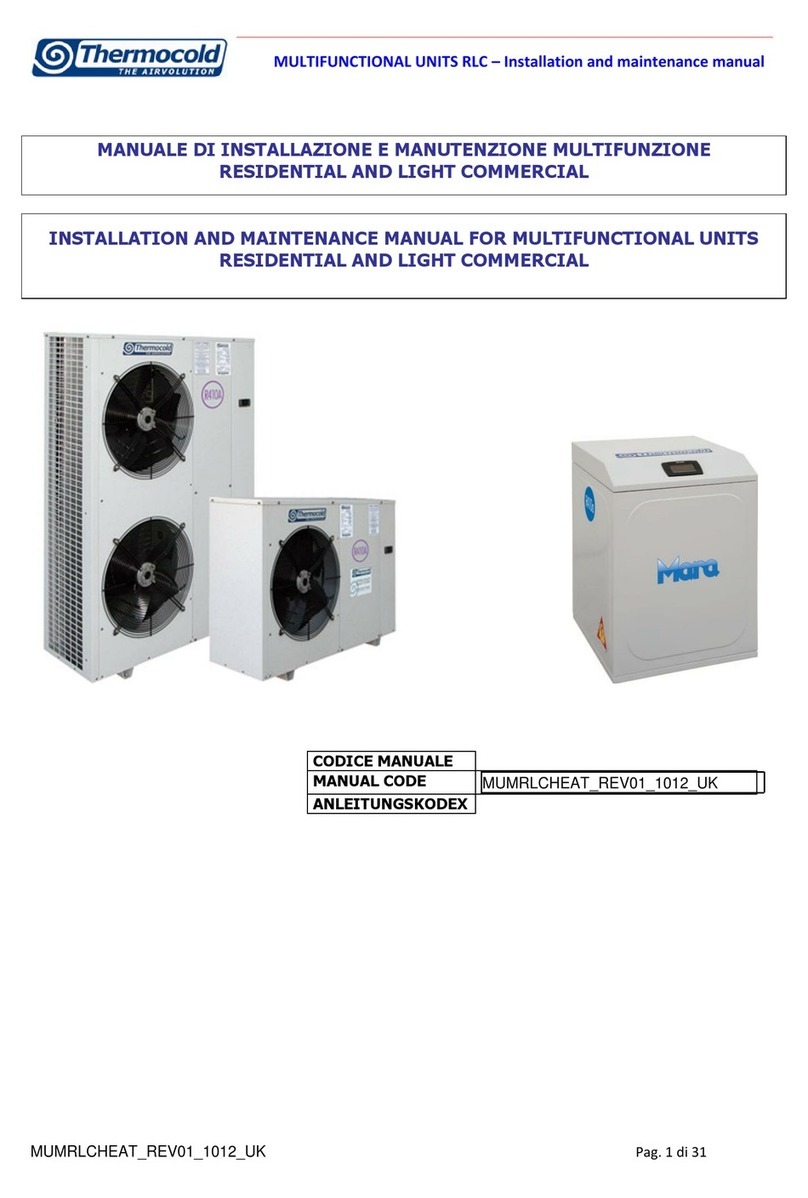
Thermocold
Thermocold MULTIFUNCTIONAL UNITS RLC Installation and maintenance manual

Midea
Midea MSV1-18HRN1 user manual
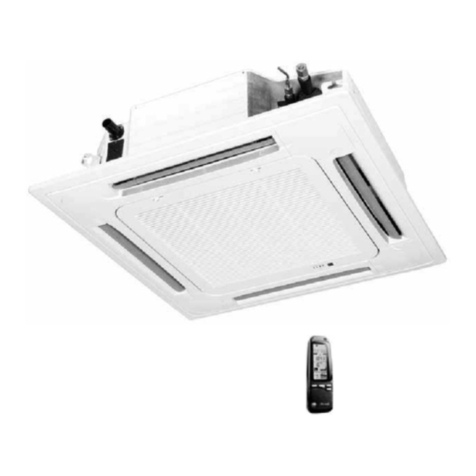
Electra
Electra KN-27SH Owner's manual & installation manual
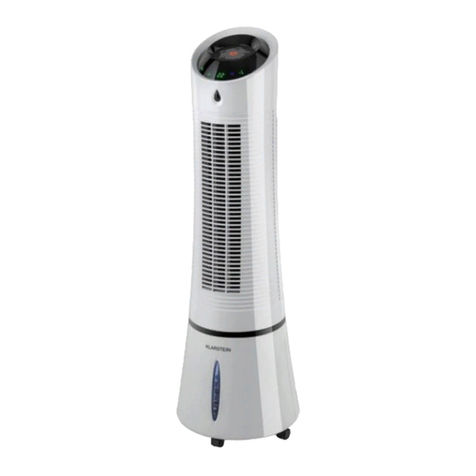
Klarstein
Klarstein SKYSCRAPER ICE SMART manual
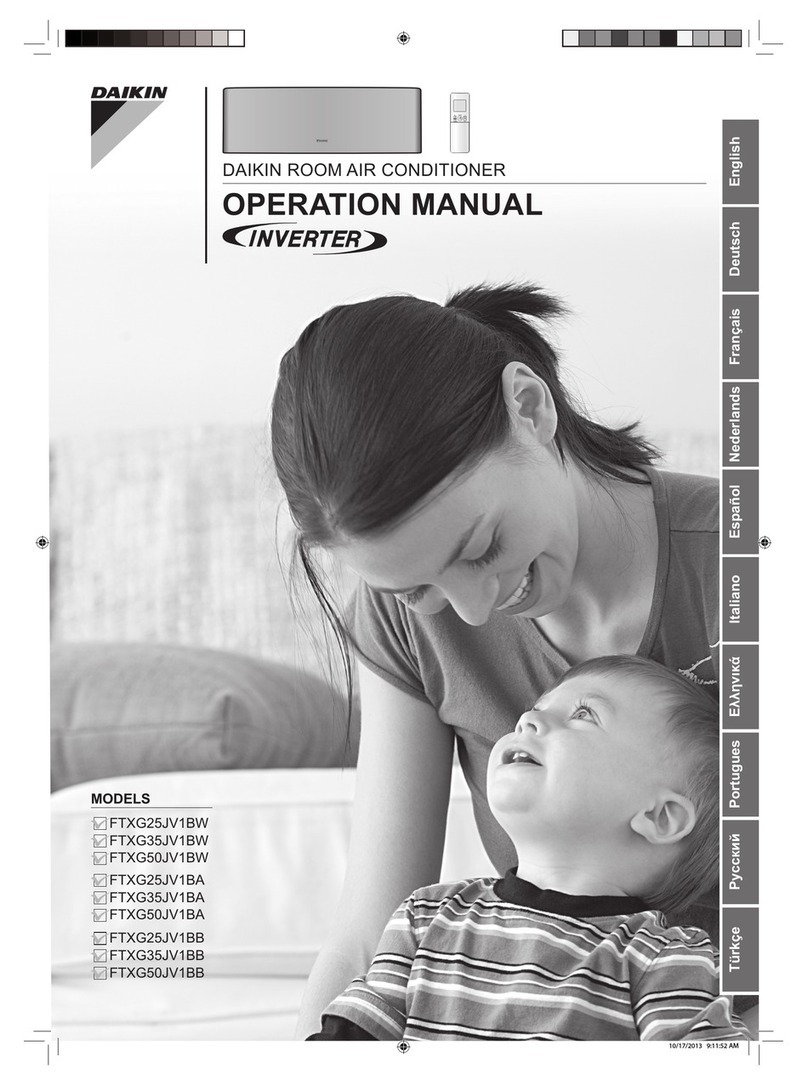
Daikin
Daikin Super Multi NX FTXG25JV1BW Operation manual
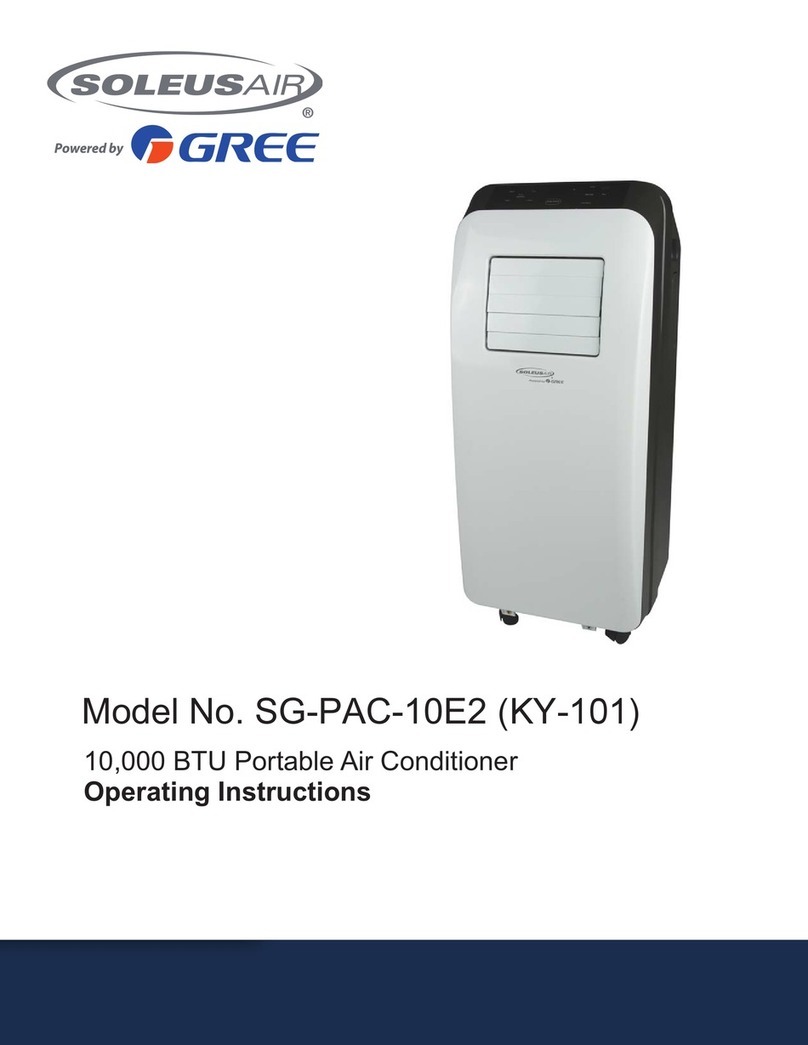
Soleus Air
Soleus Air SG-PAC-10E2 operating instructions

